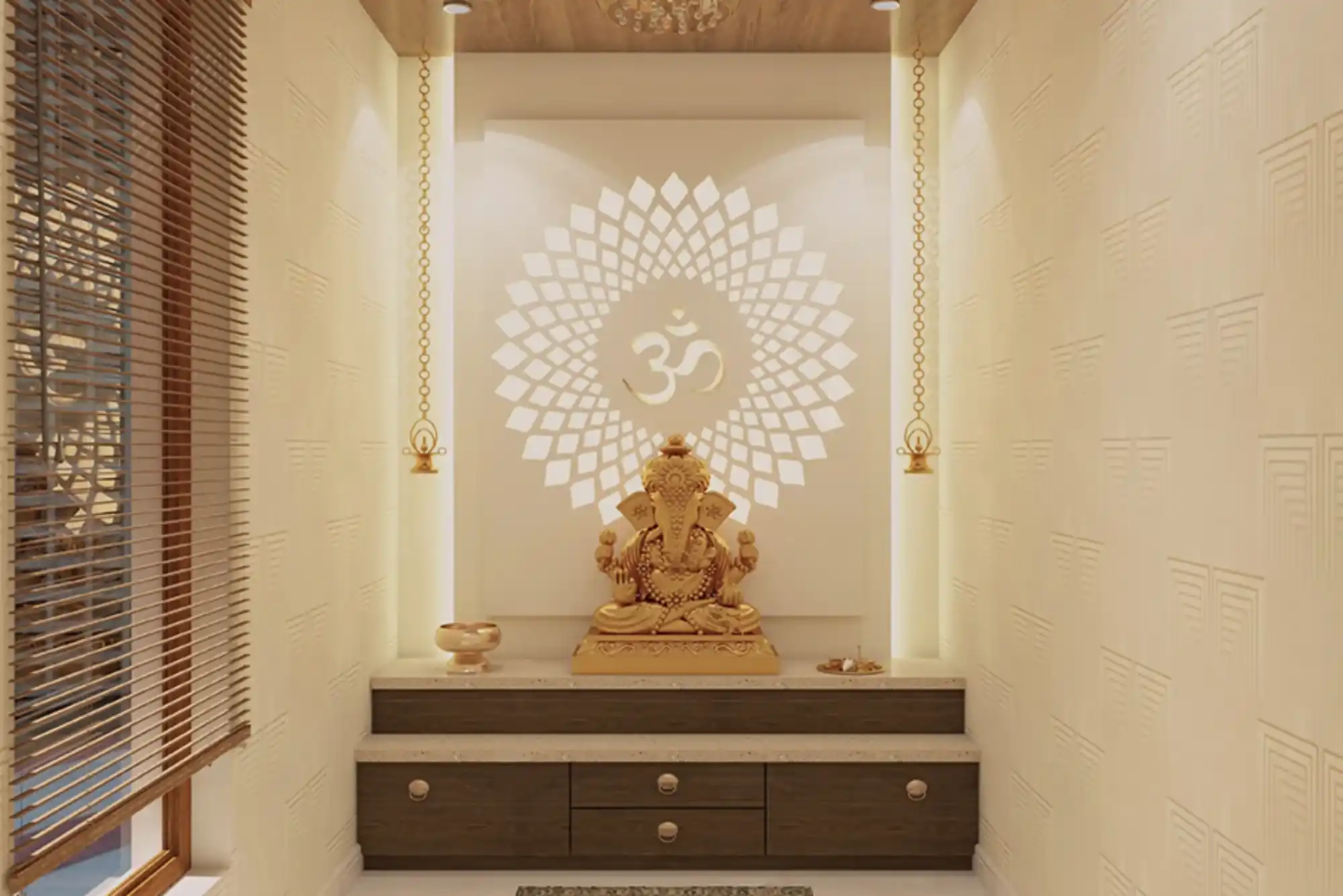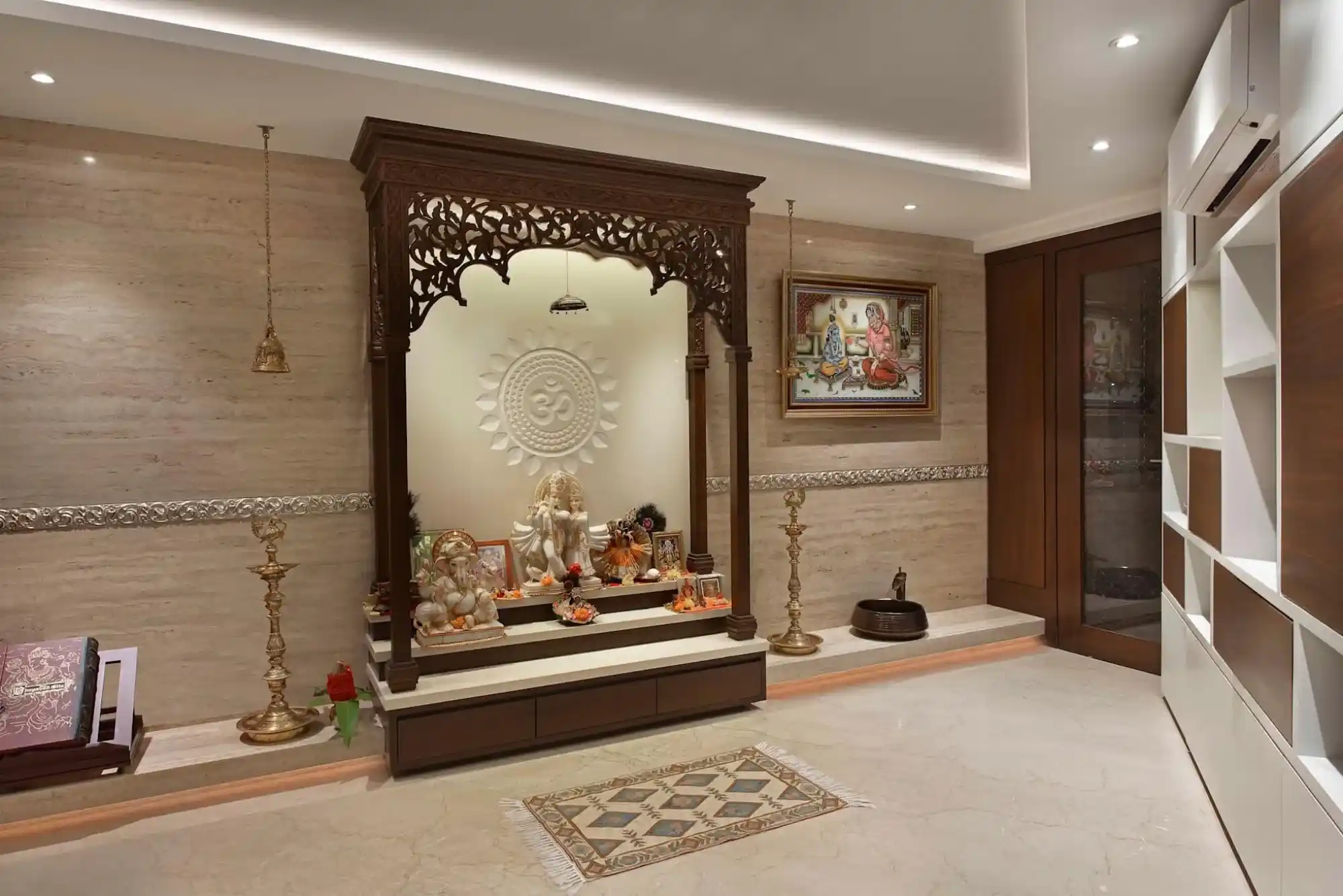A pooja room is a sacred space in Indian homes dedicated to prayer and meditation. For many families, especially those in the middle class, a well-designed pooja room is an essential part of the home. It reflects cultural values, spirituality, and devotion while being functional and aesthetically pleasing. This article explores various middle-class Indian style pooja room designs that cater to different tastes, spaces, and budgets.
Understanding the Essentials of a Pooja Room
The foundation of a pooja room lies in its essential elements. Regardless of the space or budget, certain components must be present to ensure that the pooja room serves its spiritual purpose. Key elements include:
- Idol Placement: Ensuring that idols or pictures of deities are placed at an elevated level, facing the appropriate direction.
- Lighting: Natural lighting during the day and soft, warm artificial lighting during the evening to create a serene ambiance.
- Storage: Sufficient storage for pooja accessories such as incense sticks, camphor, holy books, and other ritualistic items.
To accommodate these essentials in middle-class homes, the pooja room should be functional yet modest, focusing on the spiritual purpose of the space.
Compact and Space-Efficient Pooja Room Designs
Middle-class homes often face space constraints, making it necessary to utilize every inch efficiently. Here are some ideas:
- Corner Pooja Room: Utilize unused corners in the living room or kitchen by installing a small shelf or cabinet to house idols and pooja items.
- Wall Niches: Create wall niches with shelves to hold idols, lamps, and accessories, providing a dedicated pooja space without occupying much floor area.
- Under-the-Stair Spaces: Convert under-the-stair spaces into compact pooja rooms by adding wooden panels, shelves, and decorative lighting.
These designs are practical and can be easily customized to fit small spaces while maintaining a traditional feel.
Traditional vs. Modern Pooja Room Designs
Traditional pooja rooms typically feature wooden or marble designs, intricate carvings, and heavy use of religious symbols. However, modern interpretations offer a minimalist approach with clean lines, subtle decor, and innovative use of materials.
To create a balanced look:
- Traditional Touches: Incorporate elements like carved wooden doors, brass bells, or classic rangoli designs.
- Modern Minimalism: Use sleek shelves, contemporary idols, and understated decor to give the pooja room a fresh yet spiritual feel.
Combining both styles helps middle-class families design a pooja room that reflects tradition while embracing modernity.
Materials and Colors for Pooja Room Design
Choosing the right materials and colors is crucial to creating an inviting pooja room:
- Materials: Opt for wood, marble, or metal for pooja room cabinets, shelves, and idols. Wood, with its natural grains, adds warmth, while marble exudes purity. Metal accents like brass or copper add a traditional touch.
- Colors: Go for calming colors like white, beige, pastel shades, or light gold. These colors promote tranquility and enhance the spiritual ambiance.
By selecting the right materials and colors, you can create a harmonious and peaceful pooja room.
Lighting Ideas for a Pooja Room
Lighting plays a vital role in enhancing the pooja room’s atmosphere:
- Natural Lighting: If possible, place the pooja room where natural light can flood in, especially during the morning.
- Artificial Lighting: Use LED lamps, chandeliers, or hanging lights to illuminate the space. Traditional oil lamps or diyas can also be used to create a warm glow, adding to the sacredness of the space.
Proper lighting not only enhances the room’s aesthetic appeal but also creates a serene environment for worship.
Budget-Friendly Pooja Room Decoration Ideas
Decorating a pooja room need not be expensive. Here are some cost-effective ideas:
- Wall Art: Use simple wall art like paintings of deities, religious quotes, or motifs to decorate the walls.
- Rangoli Designs: Create colorful rangoli patterns at the entrance of the pooja room to add a festive touch.
- Flower Arrangements: Use fresh flowers or garlands to adorn the idols and the space. Consider using flower petals to create decorative patterns on the floor.
These ideas allow you to personalize your pooja room without spending a fortune.
Vastu Tips for Middle-Class Pooja Room Designs
Following Vastu Shastra principles can enhance the spiritual energy of the pooja room:
- Location: Ideally, the pooja room should be in the northeast corner of the house.
- Placement of Idols: Idols should face east or west, and never towards the north or south.
- Decor and Lighting: Ensure that the pooja room is well-lit and clean at all times.
These simple Vastu tips can help create a harmonious and spiritually uplifting environment.
Innovative Storage Solutions for Pooja Rooms
Storage is essential in maintaining a clutter-free pooja room. Some innovative solutions include:
- Wall-Mounted Shelves: Use wall-mounted shelves to store pooja accessories without occupying much space.
- Compact Cabinets: Opt for compact cabinets or drawers to store items like incense, holy books, and pooja utensils.
- Multi-Purpose Furniture: Consider furniture that doubles as storage, such as benches with hidden compartments.
Effective storage solutions help keep the pooja room organized and functional.
Personalizing Your Pooja Room
Adding personal touches to the pooja room can make it more meaningful:
- Family Heirlooms: Use family heirlooms like old religious books, photographs, or handcrafted items to decorate the room.
- Favorite Colors and Motifs: Incorporate colors, motifs, or designs that resonate with your family’s traditions and beliefs.
- Custom-Made Idols: Consider commissioning custom-made idols or decor pieces that reflect your personal devotion.
Personalizing the pooja room ensures it remains a space that feels uniquely yours.
Case Studies: Popular Middle-Class Pooja Room Designs
Let’s look at some popular pooja room designs from real middle-class homes:
- Compact Wooden Shelves in Apartments: A small wooden shelf with a door placed in the living room corner, complete with brass bells and a diya stand.
- Marble Mandir in Small Homes: A compact marble mandir placed on a raised platform in the dining area, adorned with minimal decor and proper lighting.
- Wall-Mounted Pooja Space: A wall-mounted cabinet with space for idols, a diya stand, and essential pooja items, perfect for studio apartments.
These examples demonstrate how middle-class families can create beautiful, functional pooja spaces that reflect their cultural heritage.
Designing a pooja room in a middle-class Indian home involves a careful blend of tradition, modernity, and practicality. By incorporating essential elements, space-efficient designs, and budget-friendly decor, you can create a pooja room that serves as a peaceful and spiritual sanctuary for your family.
FAQs on Middle Class Indian Style Pooja Room Designs
- What is the ideal size for a pooja room in a middle-class home?
A small room or dedicated space of around 4-6 square feet is ideal, depending on the available area. - How can I make a small pooja space look bigger?
Use light colors, mirrors, and compact furniture to make the space appear larger. - Can a pooja room be integrated into other parts of the home?
Yes, it can be integrated into living rooms, kitchens, or hallways using shelves, niches, or small cabinets.









